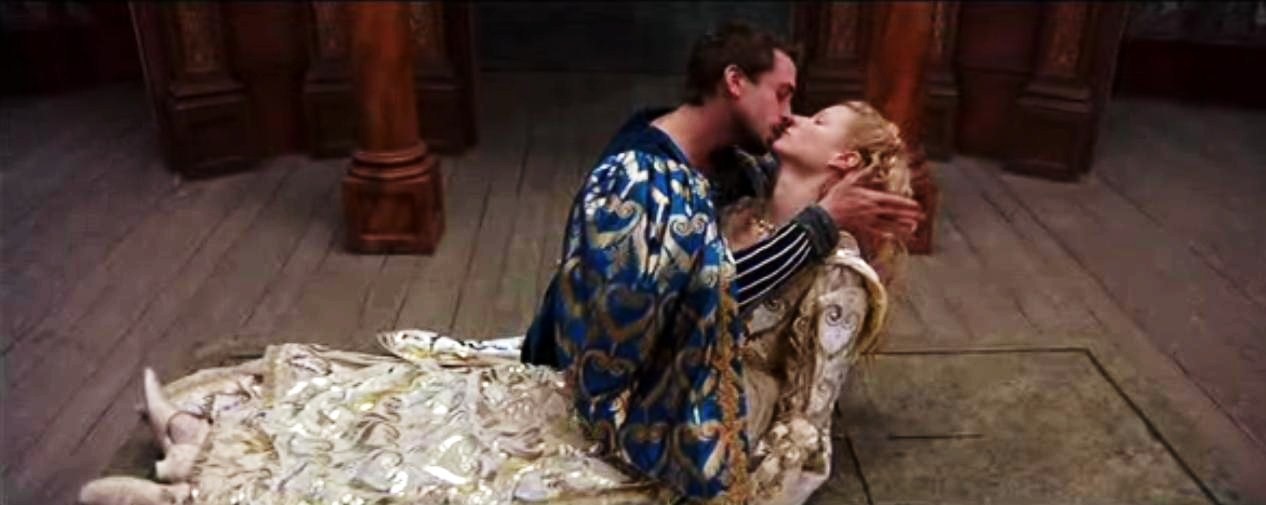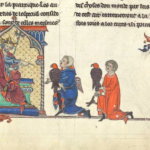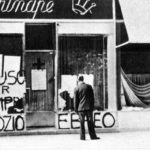
Shakespeare in Love: A Case of Cultural Appropriation?
Shakespeare didn’t write Romeo and Juliet. No! Wait, what? Shakespeare didn’t write Romeo and Juliet!?? That’s right. If the fact Shakespeare set the play in fair Verona didn’t give it away, Shakespeare didn’t create the story of Romeo and Juliet. So no, Shakespeare’s first draft of Romeo and Juliet didn’t read “Romeo and Ethel, the Pirate’s Daughter” as Shakespeare in Love portrays it. And, plot spoiler, no true-life English love of Shakespeare’s inspired the character Juliet. Nor was the war of the two houses of Verona “both alike in dignity” inspired by two playhouses duking it out for writers and audiences in London.
Don’t get me wrong. I loved the movie, and it’s kind of sad to write this article. Shakespeare in Love (Miramax, 1998) is a great movie and it was enormously successful. In many ways it is a brilliant retelling of Romeo and Juliet. By the novelty of its device, the movie allows us to enjoy Shakespeare’s genius all over again (and no bones about it Shakespeare was an inspired writer).
No doubt the screenwriters (and many who know Shakespeare well) are in on the joke, but most of the audience (even though they know that Romeo and Juliet is set in Verona) will simply assume the story came out of Shakespeare’s head. The movie cements that comforting but misplaced notion as pseudo-history.
The movie, in short, is full of misrepresentations and misdirections about the origin of the material that inspired Shakespeare’s play. This article though, is not about ‘claiming’ Shakespeare or Romeo and Juliet for Italy. The story did come from Italy, but there is a more interesting story to be told. Searching out the origin story of Romeo and Juliet brings back together what in Shakespeare’s England was not divided: English and Italian literature and arts were interconnected.
Alas, artistic licence often holds history in contempt, as for example in another great movie: Agora. And this is even more true in Shakespeare in Love. The movie is driven by its central plot device: unveiling the “real” events in Shakespeare’s life which explain the “mystery” of his genius and the sources of the words and plotlines that end up in his play. The following byline for Shakespeare in Love on IMDb gets to the heart of the issue.
“The world’s greatest ever playwright, William Shakespeare, is young, out of ideas and short of cash, but meets his ideal woman and is inspired to write one of his most famous plays.”
It’s fiction. It works. But it is cultural appropriation. This is how a more historically accurate (if less romantic) byline might read.
“England’s greatest ever playwright, William Shakespeare, is young, out of ideas and short of cash, but stumbles on a tragic Italian novella and, inspired, he adapts it to create one of his most famous plays.”
Shakespeare is perhaps not the first ‘national’ poet who we have put on a pedestal, but as in the case of other such national poets, jacking up the pedestal too high does a disservice to the art they gave us.
But first let’s take stock of what is original in Shakespeare. There is so much genius there, that there is no need to falsely claim credit for what isn’t fairly his. Well, umm, he didn’t invent the sonnet (that was the Italian poets Giacomo Lentini and Petrarch). Nonetheless Shakespeare, certainly became one of its greatest practitioners. His verses beyond that are genius.
Nor can anyone reasonably take issue with the dramatic genius of Shakespeare’s plays. These too are his own. The words that Shakespeare uses provide ample original material that is purely his own. How he adapts older stories (which were already good) elevates the telling so far, that his plays permanently consigned the source stories to the shadows of history.
Yet Shakespeare’s stories are often not original: he re-purposed, re-worked, appropriated from other sources, historical or literary. But this wasn’t unusual. In his time and place, concepts like ‘plagiarism’ and ‘copyright’ hadn’t yet taken root in the world.
In the case of Romeo and Juliet, Shakespeare’s primary source is a novella by Matteo Bandello also titled Romeo and Juliet. Bandello was a fourteenth century Italian writer, himself a native of Verona. He drew on even older Italian versions, but his version was the most direct Italian language forbear of the Romeo and Juliet story as we know it today.
By most accounts, Shakespeare didn’t know Italian (or enough Italian), so we need English translations of Bandello’s novella from which he could have got the story.
Romeo and Juliet was available in two (or even more) English language versions. In 1562 Arthur Brooke published The Tragicall Historye of Romeo and Iuliett. Brooke’s version has been shown to be the primary source material Shakespeare used. Another version was Rhomeo and Iulietta of William Painter, published in 1567. Both of these appeared well before Shakespeare’s version (dated to the 1590s). While transmission also involved a French version, and the possibility of other influences, it’s clear Shakespeare’s primary source material was Bandello’s story.
Now Matteo Bandello didn’t just write one novella. He wrote many. And his novellas were popular in Elizabethan England. Indeed, Shakespeare loved Bandello’s novellas so much that he adapted at least of his four plays from Bandello’s stories: Romeo and Juliet, Twelfth Night, Cymbeline and Much Ado About Nothing.
What is Cultural Appropriation Anyway?
Before turning to how Shakespeare in Love deals with its sources, we need to define “cultural appropriation“. There are various versions of it: and if we mean that we should never learn from each other; never take the good from what our fellow human beings are doing; never re-tell older stories that convey human wisdom if they come from “beyond” the “border”; never celebrate cultures which are not our own; never buy goods and fashions from elsewhere in the world – it would be a terrible and oppressive notion. But that is not what is usually meant.
One aspect of the idea is that it is wrong to take from or to profit from a culture to which we do not belong without due acknowledgement and recompense, and usually only with consent. Worse still to misrepresent something taken from another part of the world as belonging to our own cultural tradition; making invisible the debt which is owed. This is what Shakespeare in Love ends up doing.
Another aspect of cultural appropriation usually cited is some kind of colonial power imbalance between the exploiting and exploited culture. That certainly wasn’t the case so far as Italian countries (then plural) were concerned in Shakespeare’s time. Italy was copied because it was admired in his England, not because Shakespeare was trying to exploit or misrepresent it (as we shall see below). However history is a hot ugly mess and other European powers (the French, Spanish and Austro-Hungarian powers in particular) repeatedly colonised Italy’s geography.
In the nineteenth century, Britain got in on the act and its interests in the Mediterranean prevailed. Indeed, the Italy we know of today would not exist but for Britain’s great power interest. Think also of the Elgin marbles (which Britain also acquired in the nineteenth century Mediterranean) and you get the picture. The misuse, we are concerned with occurred after that history.
There is of course no real comparison between any two particular cases, nor with the kind of exploitation that happened in Britain’s colonies. And for that matter Italy itself became part of the European racist colonial enterprise in the late nineteenth and first half of the twentieth century (a topic for another time).
Nonetheless, it’s hard to think of a term that better fits this situation.
Cultural Appropriation in Action in Shakespeare in Love
At one point, the screenwriters seem perhaps a little sheepish about the end result of their screenplay: about how they treat the Italian origins of the play (although those origins are never mentioned). There is only one mention of Italy in the movie: Marlowe (Shakespeare’s rival) is giving Shakespeare a helping hand at that point. Shakespeare hasn’t yet written a word and thinks the play will be about pirates. Marlowe says to him that “Romeo is Italian. Always in and out of love.” He then suggests Shakespeare make “Ethel” the daughter of Romeo’s enemy.
The Italian stereotype is of course tiresome, but here is grudging (or perhaps backhanded) acknowledgement of true source of Romeo and Juliet. A little later Marlowe suggests the addition of Mercutio as a character. Here the screenwriters glide over (or perhaps miss) a connection with one of Bandello’s characters, Marcuccio. Later still in the movie Shakespeare replaces “Ethel, the Pirate’s daughter” with Juliet, at the suggestion of the actor playing Mercutio.
The name “Ethel” of course evokes a ‘national’ Anglo-Saxon origin, as does the figure of the “Earl of Wessex” (a then non-existent earldom) created to represent the marriage that the movie’s “Juliet” (Viola de Lesseps) is trying to escape. In Shakespeare in Love, Viola is the ‘real-life’ inspiration for the Juliet of Shakespeare’s play. The Earl of Wessex serves as the origin story for the nobleman Paris, to whom Juliet is unwillingly betrothed. The ‘Englishness’ of the story is further heightened by frequent appearances of Queen Elizabeth the First (who directly and indirectly replaces Verona’s ‘prince’ in the narrative).
In Shakespeare in Love, the ‘real’ experiences of Shakespeare in Shakespeare in Love, as he pursues Viola as a love interest, inspires the famous Romeo and Juliet balcony scene. These and many other elements however also in fact come from Bandello’s earlier version (as we see below).
In short, in support of the movie’s central thesis, moments of inspiration come to Shakespeare, which he then feverishly pens in his garret, immediately as he encounters them, in his lived experience in London, thereby creating Romeo and Juliet as a new and entirely original story. It is not Bandello and Verona that inspire Shakespeare; it is London. This is the misdirection, the misappropriation, at the heart of Shakespeare in Love.
The connections between the English and Italian Romeo and Juliet
However, in truth, Shakespeare drew his inspiration as much from the literature he read as the life he lived. Undoubtedly moments of life (as well as his insights into human nature and gift with language) make Shakespeare’s plays wonderful, but to leave out the literature he read is to impoverish what he has given us and takes away a whole dimension of Shakespeare’s life.
Much of the delight in watching Shakespeare in Love comes from the echoes in it of words, phrases and stories from Shakespeare’s (and just as much) Bandello’s work which make the movie work. If we know about Bandello, it adds another layer of richness to a play like Romeo and Juliet and would have done for the movie, had its screenwriters found a way to weave him in.
It is our habit to divide the world into neat national packages with their own gloriously separate national stories (it is a consequence of the hyper-nationalism of the 19th century Europe that we see the world in this way). Nations tend to be particularly protective of their national poets (and misuse of Dante in that regard is again a topic for another time). Of course, the world is more complicated and profoundly more interconnected than that. And this habit of seeing the world through national lenses can cloud our understanding of what is there in plain view.
The words “In fair Verona” which open Shakespeare’s Romeo and Juliet forever embed Italy in the heart of English literature. Indeed fully half of Shakespeare’s plays are set in Italy (if those dealing with British history are put aside). Even more have an association with Italy. Further, there was nothing unusual about this outsized influence of things Italian in Elizabethan England. Elizabethan playwrights, authors and poets loved to write about Italy.
For near on a century Italy was the height of fashion in the English public mind. Centuries later, English was to return the favour when Alessandro Manzoni based the first modern Italian novel, The Betrothed, on English Romantic historical novels like Ivanhoe. For that matter, we find older evidence of stories connected with Britain in Italian literature, as should not be surprising. In Dante’s famous verses on the forbidden love of Paolo and Francesca in Canto V of Inferno, it is reading the stories of love between Lancelot and Guinevere which tempts Paolo and Francesca to their damnation and death. It was a story that had arrived in Italy via its French versions. Such stories, now known as the Matter of Britain, circulated widely in Europe.
Romeo and Juliet Begins
We need to push a little further to get to the root of things, but it’s worth the diversion, as it opens out yet another world. Where did the story of Romeo and Juliet come from? We can trace the Shakespearian version back through Brooke (already mentioned above), to the French version he translated. This was the version by Pierre Boaistuau who in 1559 published a collection of six of Matteo Bandello’s novellas titled Histoires tragiques.
Matteo Bandello adapted his version from an earlier version by Luigi da Porto; which he published in 1530 under the title Istoria novellamente ritrovata di due nobili amanti (A Newly-Discovered Story of two Noble Lovers). Bandello’s version was closely based on da Porto’s version.
Although da Porto depicts the story as if it is a true account of happenings in Verona, this is most likely untrue. In fact, he took many of the elements of the story from a version published in 1476 by Masuccio Salernitano titled Mariotto and Giannozza in his collection of novellas called Il Novellino. After that the trail goes cold. Some claim that Masuccio might have got elements from ancient stories. Others suggest he drew a lot of his ideas from Boccaccio. In truth it was Masuccio Salernitano who gave us the first recognisable version of Romeo and Juliet.
Although many of the elements in Masuccio’s version are familiar, he set it in Siena rather than Verona. Most interesting in his version is that rather than fleeing to a nearby city, Mariotto (i.e. Romeo) flees to Alexandria in Egypt to find shelter with his merchant uncle who is located there. Giannozza (Juliet) feigns her death and with the help of a friar she tries to follow Mariotto to Alexandria and sends messages on ahead that go astray due to pirates.
The father of Masuccio’s Juliet is a noted and highly esteemed citizen of Siena who is perhaps of a “Saracen house”: i.e. of a Muslim family (although it may also mean the surname “Saraceni” which would indicate a more distant Muslim heritage).
The end of the story is much as in the later versions, with both the lovers dead. Other elements of Romeo and Juliet, as we know it, appear to have been taken from other of Masuccio’s novellas, which have similar plot elements and which da Porto included in his version.
In passing from Masuccio to da Porto, a whole cultural world, with which Italy was connected across the sea, is erased, much as Shakespeare in Love erases Italy. Both reflect changing fashions which end up giving us profoundly distorted visions of history. Italy was as much part of the Mediterranean world as it was of the European. This erased plot element is an echo of the Matter of France, an older set of European stories from France the context of which was the medieval conflict and interchange between the European and Islamic worlds. These stories were told all over Europe and were very influential in Italy, for example giving us one of the great classics of Italian literature: Orlando Furioso.
Above, I repeated the generally held opinion that Petrarch, and before him Giacomo Lentini, invented the sonnet in Italy. Now here’s the thing. Maybe that’s wrong. Giacomo Lentini was a member of the court of the Holy Roman Emperor Frederick II (known to his friends as the “Wonder of the World” and to his enemies as the “Sultan of Lucera“).
Lentini was therefore surrounded by Sicilian, Arabic, Latin and Greek; which existed side by side and were equally valued in Frederick’s court. At least one scholar argues that Giacomo Lentini got his model for the sonnet from the Arabic poetry known as the muwashshah, with which he was likely to be familiar. Sometimes these claims turn out to be true. And there’s one thing we know for certain about how Europe treated its debt to the Arabic speaking civilisation that was its neighbour: it was a combination of appropriation and denial; which to return to our theme, is pretty much what Shakespeare in Love also does.
So what did Bandello (and his predecessors) give us anyway?
The following are some of the elements of Bandello’s version that Shakespeare re-uses. The story’s setting. The names of virtually all of the characters. The conflict of the two houses. The figure of Rosaline. The displacement of Romeo’s infatuation with her, to love with Juliet. The balcony and conversations between Romeo and Juliet. An elderly lady who cares for Juliet and who acts as Juliet’s go-between (i.e. the nurse). Juliet’s demand that Romeo marry her to which he agrees.
Friar Lawrence (Lorenzo), who is an expert in alchemy and lore, who marries them in secret, and whose skills later provide the sleeping draught that simulates death. The death of Tybalt at Romeo’s hand and Romeo’s exile to Mantua. Juliet’s melancholy at his exile and the decision of her family to force her to marry count Paris because of that melancholy. The outrage of her father and threats towards Juliet if she does not marry.
Juliet’s declaration to the friar that she will kill herself if the friar does not help her. His invention of the plan by which she can escape the marriage with Paris by using the sleeping potion to pretend to be dead. Her fear before taking the poison as to what she will see when she is in the tomb and her hesitation before taking the poison. Her simulated death using the potion and some subterfuge on her part so she is not caught by the nurse. The message sent by the friar to Romeo in Mantua going astray because of the plague. The death of the two lovers in the tomb. The reconciliation of the two families (although temporary in Bandello’s version).
In short, almost the entire plot that Shakespeare later adapted in the play which audiences love so much today. But adaption it was: Shakespeare did not invent the story.
Even in some cases, Bandello’s version is more poignant and beautiful than even Shakespeare achieves. An example is the monologue Bandello gives Romeo when he learns of Juliet’s death, which is lost from Shakespeare’s version. Also lost are the final scenes in which Juliet awakens before Romeo dies and they speak together again, before both their deaths. Both of these elements were lost in the process of translation into English and appear to have been unknown to Shakespeare. They are interestingly clear proof that Shakespeare wasn’t aware of the Italian version, for it is difficult to believe he would have left these elements on the cutting room floor.
We Owe Something to Shakespeare don’t we?
The comparison with Bandello also helps us see more clearly what is genuinely Shakespeare’s in his play. The choice of words and lyrics are uniquely his own and they are superb. But he also introduces certain plot elements that enhance the story. His use of characters like Benvolio, Mercutio, Samson and Gregory enhance the story through a comic element absent in Bandello. Also introduced by Shakespeare as his play begins, is a comic sexual double entendre of which he makes liberal use (compensation perhaps for the explicit loves scenes in Bandello which Shakespeare could not put on stage in the straight-laced Elizabethan era).
Shakespeare makes Mercutio, who is a marginal character in Bandello’s version, into an important and poignant character. He plays significant role in the conflict between Montagues and Capulets. The words, “a plague on both their houses“, which Mercutio utters, is an illustration of how Shakespeare reworks stories and takes them to the next level. Mercutio uses the phrase as he dies at the hand of Tybalt. Mercutio repeats the phrase three times; and it is masterly. For here is both curse and prophesy, foreshadowing the doom that is to befall Romeo and Juliet and their entire families.
Shakespeare introduces an argument between Tybalt and Lord Capulet at the Capulet ball. This further brings to life Tybalt’s violent nature. Shakespeare introduces the meeting between Paris and Romeo in the tomb in which Romeo ends up killing Paris. All of these enhance the drama, violence and tragedy of the plot.
Sometimes we can see how Shakespeare has adapted his material to the stage. For example he removed the nurse from Juliet’s bed, so that Juliet can express her fears in a monologue. Only the audience hears this monologue before she takes the potion. In Bandello’s version these are her inner thoughts, she does not utter them aloud.
Such insights are only possible if Matteo Bandello’s version is read. When so much of the story is Bandello’s (and indeed some before him), there is something to be said for keeping their memory alive.
Engaging in wish fulfilment that Romeo and Juliet is purely English, as Shakespeare in Love does, is finally more than a little at odds with the essence of the Bard. A large part of his genius was taking and re-working so many stories from far beyond England’s shores. He put it, indeed, on stage for all the world to see.
At the end of the day, it still doesn’t stop me appreciating Shakespeare in Love for the original artistic work that it is. It’s a great movie. If I haven’t ruined for you yet, it’s worth watching. But after that take the time to read Bandello’s version as well.
Notes
I am not the first to write on this topic, although I only found an article dealing with the issues explored here as I was completing this article. That previous article (by a scholar of theatre) is now only available as an archived webpage. Interested readers are referred to “Shakespeare in Love – The Suppressed Italian Connection” by Nicholas A. Patricca. He comments in relation to his own article: “I had been forewarned that the movie Shakespeare in Love was not historically accurate. I was prepared to accept this fact in the name of entertainment. But, about halfway through the movie, I was overcome by my long-simmering feelings concerning the English-speaking world’s neglect of Shakespeare’s reliance on Italian literature.
I was not provoked into writing this essay, however, until I chanced upon a newly reissued Romeo and Juliet with a preface by a scholar who actually opined that it was “obvious” that Will Shakespeare wrote Romeo and Juliet as a young man fresh in the throes of his first experience of “true love”. To set the record straight, Shakespeare was at least 30 years old and the father of three children when he wrote R&J; he had experienced more than one episode of love, true or romantic or otherwise
… When I started teaching theatre history at Loyola University, Chicago, I continued to experience the fact that the majority of histories and commentaries I read entirely ignored Shakespeare’s use of Renaissance Italian literature. “
Sources Include
Kamal Abu-Deeb, The Quest for the Sonnet: The Origins of the Sonnet in Arabic Poetry
Matteo Bandello: Twelve Stories, translated by J.C. Nimmo (London 1895)
Matteo Bandello: Novelle, Liber Liber
Arthur Brooke, Romeus and Iulet in Originals and Analogues Part 1
Murray J. Levith. Shakespeare’s Italian Settings and Play. Macmillan Press
Vincenza Minutella, Reclaiming Romeo and Juliet: Italian Translations for Page, Stage and Screen, Brill 2013
William Paynter, The Palace of Pleasure (Story 25)
Shakespeare’s Narrative Sources: Italian Novellas and their European Dissemination: Romeo and Juliet, University of Verona
Shakespeare’s Romeo and Juliet: Massachusetts Institute of Technology
Image Credits






2 Comments
Michael Curtotti
Thanks Ned, Appreciate the comment. A concept I have been thinking about is how scholars sometimes think about ‘Homer’ – i.e. as several poets rather than one – who are lost in the mists of time. Shakespeare is perhaps a bit like that. I have been tempted to write about the theories around Shakespeare, but I wanted to hang off until I know more about the transmission pathways of his various plays. I think there is more work that scholars could do in careful comparison of the various sources to his plays and in making how Shakespeare uses his sources better known. Amelia Bassano is certainly an interesting figure and under celebrated in her own right.
Ned Walker
Fascinating article and deeply researched. Thank you. The availability of the Italian stories in translation to English at Shakespeare’s time may be the key. But I think that still gives way too much credit to Shakespeare. I am drawn to the explanation that such stories (and let’s not forget The Merchant of Venice and the Jewishness of it) come from Amelia Bassano, who somehow wrote for or behind Wm Shakespeare.